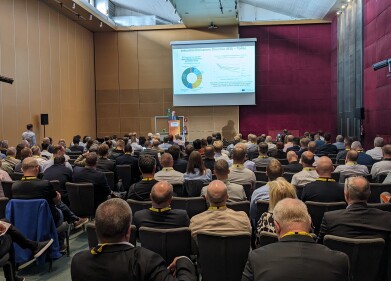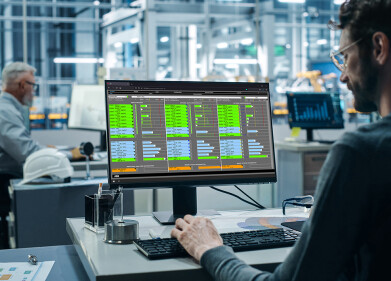Air monitoring
Construction industry research uncovers roadblock to achieve net zero.
Sep 13 2022
With little or no visibility on funding or education on offer, how can the construction industry ever succeed in reaching net zero?
As the urgency for the shift to a net zero economy becomes more prominent, a recent piece of research* has identified that nearly half (43%) of the UK construction industry is not confident they will achieve net zero by 2050.
For the sector, which contributes over 40% of the UK’s total carbon footprint, to reduce emissions and achieve net zero by 2050, it needs to address three key challenges, according to a piece of industry research commissioned by Bramble Energy.
1. Education and an understanding on the solutions available
2. A net zero ambition which is realistic and ultimately, achievable
3. Full transparency on the government funding available.
Over four fifths (81%) of participants believe the government can be clearer in how it expects the construction industry to hit carbon targets and ensure the net zero ambition is not a pipedream. The survey also revealed that over four fifths (81%) of the construction industry has not taken advantage of any hydrogen government funding schemes available to them. This is despite just under a half (48%) of the industry being aware funding is available.
The current construction landscape
Inherently the construction industry is a heavy carbon emitter and continues to be the focus of many planned government initiatives and policies, as well as public scrutiny. The urgency to act on climate change has never been greater, and the construction industry - like all others - has a moral and legal responsibility to address the climate emergency and accelerate sector decarbonisation.
It’s already demonstrating clear intent with the launch of major projects like HS2. Yet the survey revealed some genuine challenges that continue to face the sector in order to achieve net zero. Yes roadmaps are being put into place by industry experts but the picture being painted is that all parties must take their share of the responsibility. Construction firms have to become better educated on solutions and support available, and the government has to be more transparent in its support.
In 2021, the UK government tipped hydrogen as being one of the country’s carbon cutting solutions by launching a dedicated strategy to kick-start the UK in becoming a world-leading hydrogen economy. The vision promises to unlock up to £1 billion in UK government support for hydrogen and other low carbon technologies, including over £400m for hydrogen specifically. This received huge criticism from industry experts claiming the amount of funding will mean the UK will struggle to deliver at scale because it is dwarfed by the billions earmarked by European counterparts like Germany and France.
More than 100 organisations led by the UK Green Building Council (UKGBC) launched the Whole Life Carbon Roadmap - a vision and actions for achieving net zero carbon in the construction and demolition of buildings and infrastructure.
Innovation and the appetite are there
Construction sites are often blank canvases with no easy way of accessing grid power. Energy therefore needs to be brought in externally via generators to meet the massive power demands of critical equipment. Using sustainable solutions is currently difficult here and trying to electrify this equipment is very difficult. However, sector innovation is ramping up in terms of the green solutions that aren’t just newly available but being readily used.
The issues of awareness, knowledge and viability remain. Yet we are starting to see a greater choice in terms of the green alternatives available, which will become more cost effective over time. Many firms are turning away from diesel and towards clean off-grid power in the form of solar hybrid generators and hydrogen electrolysers. The benefits of hydrogen power are well documented. Not only does it help reduce carbon footprint, it is reliable and easy-to-use, its only emission is water and when in operation is virtually silent. Yet what is stopping the construction industry from implementing it, is cost with 65 percent of participants claiming it was their biggest barrier to entry - from cost of raw materials and overall operating costs to cost of replacing legacy equipment and initial investment.
The survey did reveal that four percent of the construction industry have already started to implement hydrogen, with another six percent considering it in the very near future. The good news is innovation continues. Last year Siemens Energy installed a zero-emission hydrogen fuel cell to provide off grid power to the National Grid’s Viking Link construction site and JCB announced earlier this year its development of the construction’s first ever hydrogen powered excavator.
As more and more construction firms start to strategically prioritise or consider the pursuit of a sustainable world, the more change becomes a reality in how the industry currently powers its sites. The race to net zero is proving to the world that hydrogen will be part of the solution in tackling carbon emissions - for today and tomorrow.
The climate crisis is the biggest challenge humanity faces and speed is of the essence. COP26 presented a stark warning of the dangers involved when ignoring climate change and lack of action. Everyone has a part to play - this includes the construction industry, but more importantly, those who have access to insight, knowledge and tools to bring it to the forefront and make tackling climate change a collaborative effort.
Introducing environmental monitoring and SD04
Construction companies must be compliant with local, national, and where appropriate international legislation when it comes to Noise, Dust and Vibration monitoring. Battery and grid powered equipment isn’t always viable, particularly during the early stages of a project when the site lacks a grid connection, which is why Bramble Energy has launched the SD04 hydrogen fuel cell generator.
Lightweight and a portable solution rated at 60W, the fuel cell is perfect for applications that require long-duration, off-grid power supply with zero emissions at point of use. It has been designed to reduce maintenance cycles for both the environmental monitoring contractors and sub-contractors and the end user. The result; cost-saving benefits and improving workforce utilisation. There are no moving parts and fuel cells produce electricity for as long as hydrogen is supplied.
The product has the capability to further decrease the maintenance and service intervals, resulting in a further reduction in cost. How? By manifolding additional cylinders into the system architecture, thus increasing the cycle time e.g., x2 hydrogen cylinders would last 10-14 days before they require replenishment.
Thinking ahead…
Increased environmental awareness coupled with the removal of duties and the ever-increasing price of fuel means new alternatives need to be found. Market forces are accelerating change. Customers, shareholders, etc, will increasingly demand net zero, narrowing market opportunities for those businesses that don’t adopt new technology. International unrest and increasing deglobalisation will drive greater national energy independence, bringing down the price of renewable alternatives, which means total cost of ownership of new fuelled systems will be increasingly competitive versus traditional systems.
Digital Edition
AET 28.4 Oct/Nov 2024
November 2024
Gas Detection - Go from lagging to leading: why investment in gas detection makes sense Air Monitoring - Swirl and vortex meters will aid green hydrogen production - Beyond the Stack: Emi...
View all digital editions
Events
Jan 12 2025 Abu Dhabi, UAE
Jan 14 2025 Abu Dhabi, UAE
Jan 20 2025 San Diego, CA, USA
Carrefour des Gestions Locales de L'eau
Jan 22 2025 Rennes, France
Safety, Health & Wellbeing LIVE
Jan 22 2025 Manchester, UK



















